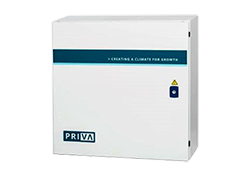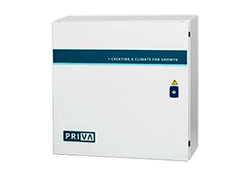What Is a Smart Greenhouse Controller?
A smart greenhouse controller is an electronic system that automates the management of greenhouse conditions. Equipped with sensors and actuators, it monitors various environmental parameters and adjusts them to create optimal growing conditions for crops. Unlike manual systems, a smart controller continuously collects data and makes real-time adjustments without human intervention, ensuring the greenhouse operates at its best at all times.
Key Features of a Smart Greenhouse Controller
Temperature Control: Plants thrive within specific temperature ranges, which vary depending on the species. A smart controller can regulate heating and cooling systems to maintain the perfect temperature inside the greenhouse. This not only prevents temperature extremes but also saves energy by avoiding unnecessary heating or cooling.
Humidity Regulation: Maintaining the right humidity level is crucial for preventing diseases like mold and promoting healthy plant growth. A smart greenhouse controller monitors humidity levels and activates misting systems or dehumidifiers when needed, ensuring that the air inside the greenhouse stays at the optimal level.
Light Control: Different plants have different lighting requirements. The smart greenhouse controller can adjust artificial lighting systems or open and close shades to optimize light exposure, mimicking natural daylight cycles. It can also manage grow lights, which is essential for plants that need specific light wavelengths for photosynthesis.
Soil Moisture Monitoring: Overwatering or underwatering can be detrimental to plants. With moisture sensors embedded in the soil, the smart controller can detect the water content and activate irrigation systems as needed. This ensures that plants receive the right amount of water, reducing waste and conserving resources.
Ventilation and CO2 Management: Proper airflow and CO2 levels are important for plant respiration and growth. The controller can automatically open vents, turn on fans, or adjust CO2 levels, providing plants with a steady supply of fresh air and carbon dioxide.
Data Logging and Remote Access: Many modern greenhouse controllers offer data logging features, allowing farmers to analyze long-term trends and make informed decisions about crop management. Additionally, these systems often come with remote access capabilities, enabling farmers to monitor and adjust greenhouse conditions from their smartphones or computers.
Benefits of a Smart Greenhouse Controller
Increased Productivity: By maintaining the perfect growing conditions, smart greenhouse controllers significantly enhance crop yield and quality. Plants grow faster, healthier, and with fewer losses due to environmental stress.
Energy Efficiency: Automation reduces the need for manual labor and allows for more precise control of resources like water, light, and energy. By only using what is necessary, farmers can cut down on energy consumption and reduce costs.
Sustainability: With optimized resource management, smart Priva promote sustainability. By minimizing waste and improving resource efficiency, they contribute to more eco-friendly agricultural practices.
Reduced Labor Costs: Farmers no longer need to manually adjust temperature, humidity, or water levels. With the system managing these factors, labor costs decrease, freeing up time for other farm management tasks.
24/7 Monitoring and Alerts: Smart greenhouse controllers provide round-the-clock monitoring. In case of any issues, such as equipment failure or sudden environmental changes, the system can send real-time alerts, allowing farmers to take immediate action before problems escalate.






Comments